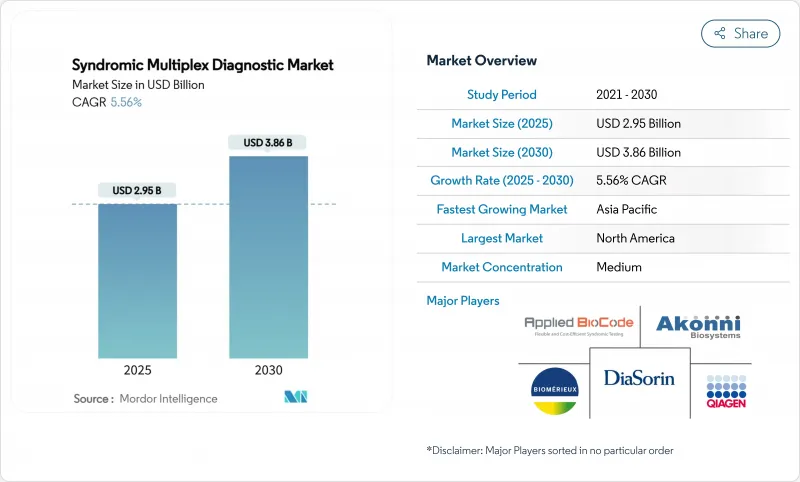
|
市場調査レポート
商品コード
1852135
シンドロミックマルチプレックス診断:市場シェア分析、産業動向、統計、成長予測(2025年~2030年)Syndromic Multiplex Diagnostic - Market Share Analysis, Industry Trends & Statistics, Growth Forecasts (2025 - 2030) |
||||||
カスタマイズ可能
適宜更新あり
|
|||||||
| シンドロミックマルチプレックス診断:市場シェア分析、産業動向、統計、成長予測(2025年~2030年) |
|
出版日: 2025年08月08日
発行: Mordor Intelligence
ページ情報: 英文 115 Pages
納期: 2~3営業日
|
概要
シンドロミックマルチプレックス診断市場規模は2025年に29億5,000万米ドルに達し、2030年には38億6,000万米ドルに達すると予測され、この期間のCAGRは5.56%です。

この拡大は、1つの検体から複数の病原体を同定し、検体採取から標的治療までの期間を短縮する精密検査への世界的なシフトに直接起因しています。呼吸器系検査パネルは、パンデミック後の病院への投資と、医師がマルチプレックス呼吸器系ワークフローに慣れ親しんでいることに後押しされ、依然として主要な収益源となっています。同時に、神経学に特化したパネルは、他のすべての臨床カテゴリーを凌駕しています。これは、臨床医が髄膜炎や脳炎の症例に対してより迅速な回答を求めているためであり、このような症例は遅れが死亡率の上昇につながります。テクノロジーの採用は、このような臨床の優先順位を反映しています。マルチプレックスPCRは引き続き主流であるが、次世代シーケンサー(NGS)プラットフォームは、検査室がより広範なゲノムプロファイリングを試みているため、最も速い単位成長を記録しています。かつては数時間で結果を出していたポイント・オブ・ケア・システムが、現在では約15分で実用的な回答を返すようになり、支払者は早期介入による医療費節約を認識しています。
世界のシンドロミックマルチプレックス診断市場の動向と洞察
感染症罹患率の上昇
ウイルスや細菌の脅威が再燃しており、1回の検査で重複感染を区別できる幅広い呼吸器、消化器、熱性疾患パネルの需要が高まっています。WHOの2024年世界保健支出調査では、パンデミック時代の予算が予防から急性期医療に振り向けられ、マルチプレックス・アッセイが現在埋める診断ギャップを残していることが確認されました。抗菌薬耐性は、経験的治療が治療失敗のリスクを伴うため、正確な同定の必要性をさらに高めています。米国FDAが2024年にサル痘のような新興薬剤の緊急使用を認可したことは、検査室が迅速に再構成できる展開可能なパネルを求める規制当局の要望を明確にしました。この柔軟性は、リファレンス・ラボが発生地域から遠く離れた場所にあることが多いアフリカや東南アジアの公衆衛生のバイヤーを惹きつけています。一方、西欧の病院では、耐性マーカー検出をルーチンの敗血症検診に組み込んで、広域抗生物質への曝露を減らしています。
高まる分子診断技術の採用
ヘルスケア管理者は、検査ごとの価格よりも、トータルコスト削減を重視するようになってきています。Multiplex PCRは、急性呼吸器症例の平均在院日数を1日短縮し、試薬コストの上昇を相殺します。QIAGENは2024年にQIAstat-Dx呼吸器パネルと中枢神経系パネルについて複数のFDA認可を取得し、規制当局がいかにシンドロミック申請の経路を合理化しているかを示しています。デジタルPCRと等温法は成熟し、一部のプラットフォームは0.01%の対立遺伝子頻度でバリアントを検出するようになり、腫瘍学と移植モニタリングが新たな収益源として可能になりました。CLIAの免除により、米国の外来診療所でのアクセスが拡大し、シンドロミックマルチプレックス診断市場の3次センター以外への浸透が強化されました。
シンドロミック検査パネルの高コスト
普遍的な普及を阻む最大の障害は依然として価格です。インドの呼吸器パネルには、入院患者用の抗生物質の全コースと同程度の費用がかかることがあり、地方の病院は検査の割当を余儀なくされています。米国ではMolDXプログラムにより、アルゴリズムによる感度の主張以上の適用を正当化するために、メーカーに臨床的有用性に関する書類を提出するよう求めています。パネルサイズのインフレはさらに予算を圧迫します。30ターゲットのアッセイは、臨床的に関連性のあるターゲットのサブセットだけであっても、償還額の上限を超える可能性があります。そのため、利害関係者は、入院や抗生物質使用の減少と支払いを関連付けるリスクシェアリングモデルを模索しているが、そのような合意には、現在収集するサプライヤーがほとんどない縦断的な転帰データが必要です。
セグメント分析
シンドロミックマルチプレックス診断市場の2024年の売上高の42.45%は呼吸器系アッセイであり、償還と臨床医への周知が定着していることが明らかになりました。一方、中枢神経系パネルは、早期抗ウイルス療法や抗菌療法の指針となる迅速検査が神経科医に受け入れられていることから、2030年までのCAGRは7.65%と予測されます。このような需要の高まりにより、中枢神経系分野の市場シェアは現在の10%台半ばから、10年後までには4分の1に達する可能性があります。臨床医は、培養を優先する戦略では髄膜炎症例の最大50%で病原体が見落とされるため、小児や移植患者集団ではマルチプレックス分子検査結果が不可欠であると指摘しています。パネルのコモディティ化の圧力は呼吸器検査においてより顕著であり、ベンダーは純粋な分析精度よりもむしろ、より速いランタイムと接続機能によって差別化を図っています。Kariusは、メタゲノム解析と宿主応答マーカーを組み合わせた肺感染アッセイでBreakthrough Deviceの承認を得ており、呼吸器ケアの新たなフロンティアを示しています。
一方、消化器系と泌尿生殖器系のパネルは、呼吸器系と中枢神経系検査に遅れをとってはいるもの、売上高全体への寄与は着実に上昇を続けています。腸管病原菌における抗生物質耐性の上昇とスチュワードシップ・プログラムの必要性が、南アジアと東南アジアの3次医療機関における消化器系パネルの受注を刺激しています。尿路感染症および性感染症パネルは、CLIA免除の店頭承認の恩恵を受けており、地域クリニックを数量増加の原動力として位置づけています。FDAが急性熱性疾患パネルに別個の機器クラスを設けたことで、呼吸器感染症と全身性感染症にまたがるマルチシンドロームカートリッジに門戸が開かれ、現在のセグメント区分が曖昧になる可能性があります。
Multiplex PCRは依然として2024年の売上高の58.45%を占め、シンドロミックマルチプレックス診断市場シェアの最大スライスを確保しています。そのサンプル当たりのコストとターンキー・ワークフローにより、病院のラボに組み込まれ続けています。しかし、NGSのCAGRは8.12%であり、シーケンシングコストが低下すれば、支出増の一部を吸収できる可能性があります。検査室は、細菌、真菌、ウイルス、寄生虫を偏りなく検出できるNGSを高く評価しています。NGSアプリケーションに付随するシンドロミックマルチプレックス診断市場規模は、償還経路が臨床ニーズと合致すれば、2030年までに10億米ドルに近づく可能性があります。
マイクロアレイは、その限られたダイナミックレンジと煩雑なワークフローが新規導入の妨げとなっています。デジタルPCRは、低頻度の耐性変異や腫瘍における微小残存病変のモニタリングというニッチな役割を担っているが、その資本強度が普及を制限しています。DiaSorin社のLiaison Plexは、PCRとビーズベースの免疫検出をミックスしたモジュラーシステムで、2024年にFDAの認可を受けており、ハイブリッドな将来のアーキテクチャを示唆しています。
地域分析
北米は、確立された償還、電子カルテ統合、成熟した外来POCネットワークにより、2024年の売上高の41.43%を占めました。同地域のシンドロミックマルチプレックス診断市場規模は、現在の政策の勢いの下、2030年までに16億米ドルに達する可能性があります。CMSの償還が呼吸器パネルと敗血症パネルの採用を後押しする一方、ベンチャー資金が市販の分子検査を対象とする新興企業を支援します。病院グループは、パネル結果を抗菌薬管理ダッシュボードと関連付けるための集中データ分析をますます導入し、採用を強化しています。
欧州では、IVDRの遵守により継続的な市販後調査データが求められるため、着実ではあるが緩やかな拡大が続いています。公衆衛生機関は、移民に関連したアウトブレイクを迅速に検出するため、国境国にマルチプレックスの設置を助成しています。この地域の成長はPOC機器よりもミッドスループット検査システムに傾いているが、現在議論されているCLIAと同等の免除コンセプトが実施されれば、ドイツとフランスでは薬局での導入に拍車がかかる可能性があります。
アジア太平洋地域はCAGR6.43%と最も力強い軌道を描いています。中国は2022年に8兆5,000億元(GDPの7.05%)の医療費を投じ、インドは2024~2028年度の間に10~12%の診断薬成長を予測しており、デング熱、ツツガムシ病、多剤耐性結核に取り組むシンドロミック・プラットフォームに資金が向けられています。官民パートナーシップは、クラウド接続に支えられたカートリッジ式PCR装置を地区病院に供給しています。日本と韓国は、精密医療をサポートするためにNGSを導入した病院ラボのアップグレードを継続し、間接的に微生物シーケンス能力を拡大しています。
南米と中東・アフリカは収益では後塵を拝しているが、有意義な成長ポケットを示しています。ブラジルは地域インフルエンザサーベイランスのために呼吸器マルチプレックス検査に投資し、サウジアラビアは移植件数の多い3次センターでCNSパネルを試験的に導入しています。サハラ以南のアフリカでは、AFENETのCoLTePイニシアチブが検査施設の認定確保を支援し、HIVに隣接する日和見感染を扱うマルチプレックス設置のためのドナー資金を引き出します。
その他の特典:
- エクセル形式の市場予測(ME)シート
- 3ヶ月のアナリストサポート
よくあるご質問
目次
第1章 イントロダクション
- 調査の前提条件と市場の定義
- 調査範囲
第2章 調査手法
第3章 エグゼクティブサマリー
第4章 市場情勢
- 市場概要
- 市場促進要因
- 感染症の増加
- 分子診断技術の採用拡大
- 拡大するポイントオブケア検査インフラ
- シンドロミックパネルに対する有利な償還政策
- 新興国における医療費の増加
- マルチプレックスPCRとNGSプラットフォームの技術的進歩
- 市場抑制要因
- 症候群検査パネルの高コスト
- 分子診断における限られた熟練労働力
- 厳しい規制当局の承認プロセス
- 不十分な臨床検査情報システムの統合
- 規制情勢
- ポーターのファイブフォース分析
- 新規参入業者の脅威
- 買い手の交渉力
- 供給企業の交渉力
- 代替品の脅威
- 競争企業間の敵対関係
第5章 市場規模と成長予測
- 症候群タイプ別
- 呼吸器
- 消化器
- 中枢神経系
- cUTIと性感染症
- 技術プラットフォーム別
- マルチプレックスPCR
- マイクロアレイベース
- 等温増幅
- NGSベース
- パネルサイズ別
- 10ターゲット以下
- 11-20ターゲット
- 20ターゲット以上
- エンドユーザー別
- 病院
- 診断ラボ
- ポイントオブケア/リテールクリニック
- 地域別
- 北米
- 米国
- カナダ
- メキシコ
- 欧州
- ドイツ
- 英国
- フランス
- イタリア
- スペイン
- その他欧州地域
- アジア太平洋地域
- 中国
- 日本
- インド
- オーストラリア
- 韓国
- その他アジア太平洋地域
- 中東・アフリカ
- GCC
- 南アフリカ
- その他中東・アフリカ
- 南米
- ブラジル
- アルゼンチン
- その他南米
- 北米
第6章 競合情勢
- 市場集中度
- 市場シェア分析
- 企業プロファイル
- bioMerieux
- Danaher(Cepheid)
- F. Hoffmann-La Roche(GenMark)
- Abbott
- Qiagen
- DiaSorin S.p.A(Luminex)
- Thermo Fisher Scientific
- Seegene Inc.
- Becton, Dickinson and Company
- Hologic Inc.(Mobidiag)
- Randox Laboratories
- Genetic Signatures
- Meridian Bioscience
- Bosch Healthcare Solutions
- Biocartis
- AusDiagnostics
- Accelerate Diagnostics
- OpGen(Curetis)
- Akonni Biosystems, Inc.
- QuantuMDx
- Applied BioCode

